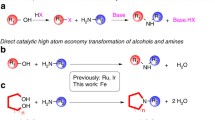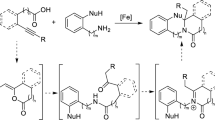Abstract
The catalytic hydrogenation of prochiral ketones and imines is an advantageous approach to the synthesis of enantioenriched alcohols and amines, respectively, which are two classes of compounds that are highly prized in pharmaceutical, fragrance and flavoring chemistry. This hydrogenation reaction is generally carried out using ruthenium-based catalysts. Our group has developed an alternative synthetic route that is based on the environmentally friendlier iron-based catalysis. This protocol describes the three-part synthesis of trans-[amine(imine)diphosphine]chlorocarbonyliron(II) tetrafluoroborate templated by iron salts and starting from commercially available chemicals, which provides the precatalyst for the efficient asymmetric transfer hydrogenation of ketones and imines. The use of the enantiopure (S,S) catalyst to reduce prochiral ketones to the (R)-alcohol in good to excellent yields and enantioenrichment is also detailed, as well as the reduction to the amine in very high yield and enantiopurity of imines substituted at the nitrogen with the N-(diphenylphosphinoyl) group (-P(O)Ph2). Although the best ruthenium catalysts provide alcohols in higher enantiomeric excess (ee) than the iron complex catalyst used in this protocol, they do so on much longer time scales or at higher catalyst loadings. This protocol can be completed in 2 weeks.







Similar content being viewed by others
References
Lin, G.Q., You, Q.D. & Cheng, J.F. Chiral Drugs: Chemistry and Biological Action (John Wiley & Sons, 2011).
Busacca, C.A., Fandrick, D.R., Song, J.J. & Senanayake, C.H. The growing impact of catalysis in the pharmaceutical industry. Adv. Synth. Catal. 353, 1825–1864 (2011).
Blaser, H.-U. et al. Selective hydrogenation for fine chemicals: recent trends and new developments. Adv. Synth. Catal. 345, 103–151 (2003).
Rodriguez, S. et al. Amine-tunable ruthenium catalysts for asymmetric reduction of ketones. Adv. Synth. Catal. 356, 301–307 (2014).
Nugent, T.C. & El-Shazly, M. Chiral amine synthesis—recent developments and trends for enamide reduction, reductive amination, and imine reduction. Adv. Synth. Catal. 352, 753–819 (2010).
Magano, J. & Dunetz, J.R. Large-Scale carbonyl reductions in the pharmaceutical industry. Org. Process Res. Dev. 16, 1156–1184 (2012).
Ager, D.J., de Vries, A.H.M. & de Vries, J.G. Asymmetric homogeneous hydrogenations at scale. Chem. Soc. Rev. 41, 3340–3380 (2012).
Johnson, N.B., Lennon, I.C., Moran, P.H. & Ramsden, J.A. Industrial-scale synthesis and applications of asymmetric hydrogenation catalysts. Acc. Chem. Res. 40, 1291–1299 (2007).
Patchett, R. et al. Asymmetric hydrogenation of ketones with H2 and ruthenium catalysts containing chiral tetradentate S2N2 ligands. Angew. Chem. Int. Ed. Engl. 52, 10352–10355 (2013).
Noyori, R. Asymmetric catalysis: science and opportunities (Nobel lecture 2001). Adv. Synth. Catal. 345, 15–32 (2003).
Ohkuma, T., Ishii, D., Takeno, H. & Noyori, R. Asymmetric hydrogenation of amino ketones using chiral RuCl2(diphosphine)(1,2-diamine) complexes. J. Am. Chem. Soc. 122, 6510–6511 (2000).
Noyori, R. & Ohkuma, T. Asymmetric catalysis by architectural and functional molecular engineering: practical chemo- and stereoselective hydrogenation of ketones. Angew. Chem. Int. Ed. Engl. 40, 40–73 (2001).
Klingler, F.D. Asymmetric hydrogenation of prochiral amino ketones to amino alcohols for pharmaceutical use. Acc. Chem. Res. 40, 1367–1376 (2007).
Zuo, W., Lough, A.J., Li, Y. & Morris, R.H. Amino(imino)diphosphines activate iron catalysts in the asymmetric transfer hydrogenation of ketones and imines. Science 342, 1080–1083 (2013).
Hashiguchi, S., Fujii, A., Takehara, J., Ikariya, T. & Noyori, R. Asymmetric transfer hydrogenation of aromatic ketones catalyzed by chiral ruthenium(II) complexes. J. Am. Chem. Soc. 117, 7562–7563 (1995).
Yamada, I. & Noyori, R. Asymmetric transfer hydrogenation of benzaldehydes. Org. Lett. 2, 3425–3427 (2000).
Baratta, W. et al. Chiral pincer ruthenium and osmium complexes for the fast and efficient hydrogen transfer reduction of ketones. Organometallics 29, 3563–3570 (2010).
Baratta, W., Chelucci, G., Magnolia, S., Siega, K. & Rigo, P. Highly productive CNN pincer ruthenium catalysts for the asymmetric reduction of alkyl aryl ketones. Chem. Eur. J. 15, 726–732 (2009).
Cheung, F.K. et al. An investigation into the tether length and substitution pattern of arene-substituted complexes for asymmetric transfer hydrogenation of ketones. Org. Lett. 9, 4659–4662 (2007).
Hayes, A.M., Morris, D.J., Clarkson, G.J. & Wills, M. A class of ruthenium(II) catalyst for asymmetric transfer hydrogenations of ketones. J. Am. Chem. Soc. 127, 7318–7319 (2005).
Morris, D.J., Hayes, A.M. & Wills, M. The 'reverse-tethered' ruthenium (II) catalyst for asymmetric transfer hydrogenation: further applications. J. Org. Chem. 71, 7035–7044 (2006).
Mikhailine, A.A., Lagaditis, P.O., Sues, P., Lough, A.J. & Morris, R.H. New cyclic phosphonium salts derived from the reaction of phosphine-aldehydes with acid. J. Organometal. Chem. 695, 1824–1830 (2010).
Lagaditis, P.O., Mikhailine, A.A., Lough, A.J. & Morris, R.H. Template synthesis of iron(II) complexes containing tridentate P-N-S, P-N-P, P-N-N and tetradentate P-N-N-P ligands. Inorg. Chem. 49, 1094–1102 (2010).
Sues, P.E., Lough, A.J. & Morris, R.H. Stereoelectronic factors in iron catalysis: synthesis and characterization of aryl-substituted iron(II) carbonyl P-N-N-P complexes and their use in the asymmetric transfer hydrogenation of ketones. Organometallics 30, 4418–4431 (2011).
Zuo, W., Tauer, S., Prokopchuk, D.E. & Morris, R.H. Iron catalysts containing amine(imine)diphosphine P-NH-N-P ligands catalyze both asymmetric hydrogenation and asymmetric transfer hydrogenation of ketones. Organometallics 33, 5791–5801 (2014).
Mikhailine, A.A., Kim, E., Dingels, C., Lough, A.J. & Morris, R.H. Template syntheses of iron(II) complexes containing chiral P-N-N-P and P-N-N ligands. Inorg. Chem. 47, 6587–6589 (2008).
Sues, P.E., Demmans, K.Z. & Morris, R.H. Rational development of iron catalysts for asymmetric transfer hydrogenation. Dalton Trans. 43, 7650–7667 (2014).
Acknowledgements
We thank the Natural Sciences and Engineering Research Council of Canada for a discovery grant to R.H.M.
Author information
Authors and Affiliations
Contributions
W.Z. performed all the experiments. R.H.M. directed the research and both authors wrote the manuscript.
Corresponding author
Ethics declarations
Competing interests
The authors declare no competing financial interests.
Integrated supplementary information
Supplementary Figure 4 The reaction of iron chloride with the diamine and phosphine-aldehyde.
The reaction of iron chloride (FeCl2), (S,S)-1,2-diphenyl-1,2-diaminoethane (S,S-dpen), sodium methoxide (NaOMe) and the phosphonium dimer [(PPh2CH2CHOH-)2Cl2] in methanol in the glovebox.
Supplementary Figure 5 Isolation of (S,S)-PPh2CH2CH2NHCH(Ph)CH(Ph)NH2.
Using dichloromethane to extract the PPh2-NH-NH2 ligand [(S,S)-PPh2CH2CH2NHCH(Ph)CH(Ph)NH2] using a separatory funnel in the air.
Supplementary information
Supplementary Figures
Supplementary Figures 1–10, Supplementary Notes 1–9 (PDF 4378 kb)
Rights and permissions
About this article
Cite this article
Zuo, W., Morris, R. Synthesis and use of an asymmetric transfer hydrogenation catalyst based on iron(II) for the synthesis of enantioenriched alcohols and amines. Nat Protoc 10, 241–257 (2015). https://doi.org/10.1038/nprot.2015.012
Published:
Issue Date:
DOI: https://doi.org/10.1038/nprot.2015.012
- Springer Nature Limited
This article is cited by
-
Pincer Ru with a single stereogenic identity for highly efficient asymmetric transfer hydrogenation of ketones
Science China Chemistry (2023)
-
The role of the metal-bound N–H functionality in Noyori-type molecular catalysts
Nature Reviews Chemistry (2018)
-
Convenient iron-catalyzed reductive aminations without hydrogen for selective synthesis of N-methylamines
Nature Communications (2017)
-
Evaluation of techniques for performing cellular isolation and preservation during microgravity conditions
npj Microgravity (2016)
-
Achiral Cyclopentadienone Iron Tricarbonyl Complexes Embedded in Streptavidin: An Access to Artificial Iron Hydrogenases and Application in Asymmetric Hydrogenation
Catalysis Letters (2016)





